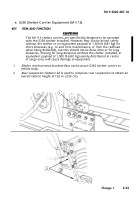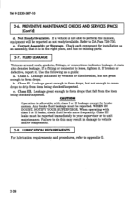TM-9-2320-387-10 - Page 71 of 277
TM 9-2320-387-l 0
WARNING
Drycleaning solvent is flammable and will not be used near an open
flame. A fire extinguisher will be kept nearby when the solvent is
used. Use only in well-ventilated places. Failure to do this may
result in injury to personnel and/or damage to equipment.
Protective gloves, clothing, and/or respiratory equipment must be
worn whenever caustic, toxic, or flammable cleaning solutions are
used. Failure to do this may result in injury to personnel and/or
damage to equipment.
CAUTION
Do not allow cleaning compounds to come into contact with rubber,
leather, vinyl, or canvas materials. Damage to equipment will result.
Do not use compressed air when cleaning vehicle interiors. Damage
to equipment will result.
Do not allow water to enter air cleaner assembly air intake
weathercap. Damage to engine will occur.
b. Cleaning
Instructions
for Ballistic Glass.
CAUTION
.
.
.
(1)
Do not clean interior surfaces of ballistic glass by any other means
than specified below.
Do not use a scraper or other objects with sharp edges that may
scratch the inside surfaces of ballistic glass.
Do not apply stickers, labels, solvents, abrasive materials, or
cleaners to ballistic glass.
Remove dust and loose abrasive particles using clean, filtered air at 20 psi
(138 kPa) maximum.
cloth, (2) Wash with mild d e te rgent and warm water. Dry using a clean, soft, lint-free
(3) Remove stubborn marks and stains using a clean, soft, lint-free cloth and
equal parts of isopropyl alcohol or ethanol and water.
(4) Repeat step 2.
NOTE
Clean windshield wipers of debris on a regular basis to ensure proper
vision.
c.
Cleaning
Materials.
Detailed descriptions of specific cleaning compounds,
cleaning solvents, drycleaning solutions, and corrosion-removing compounds are
found in TM 9-247.
d.
General
Guidelines.
Table 2-1 provides a general guide of cleaning
materials used in removing contaminants from various parts of the vehicle.
2-25
Back to Top




















